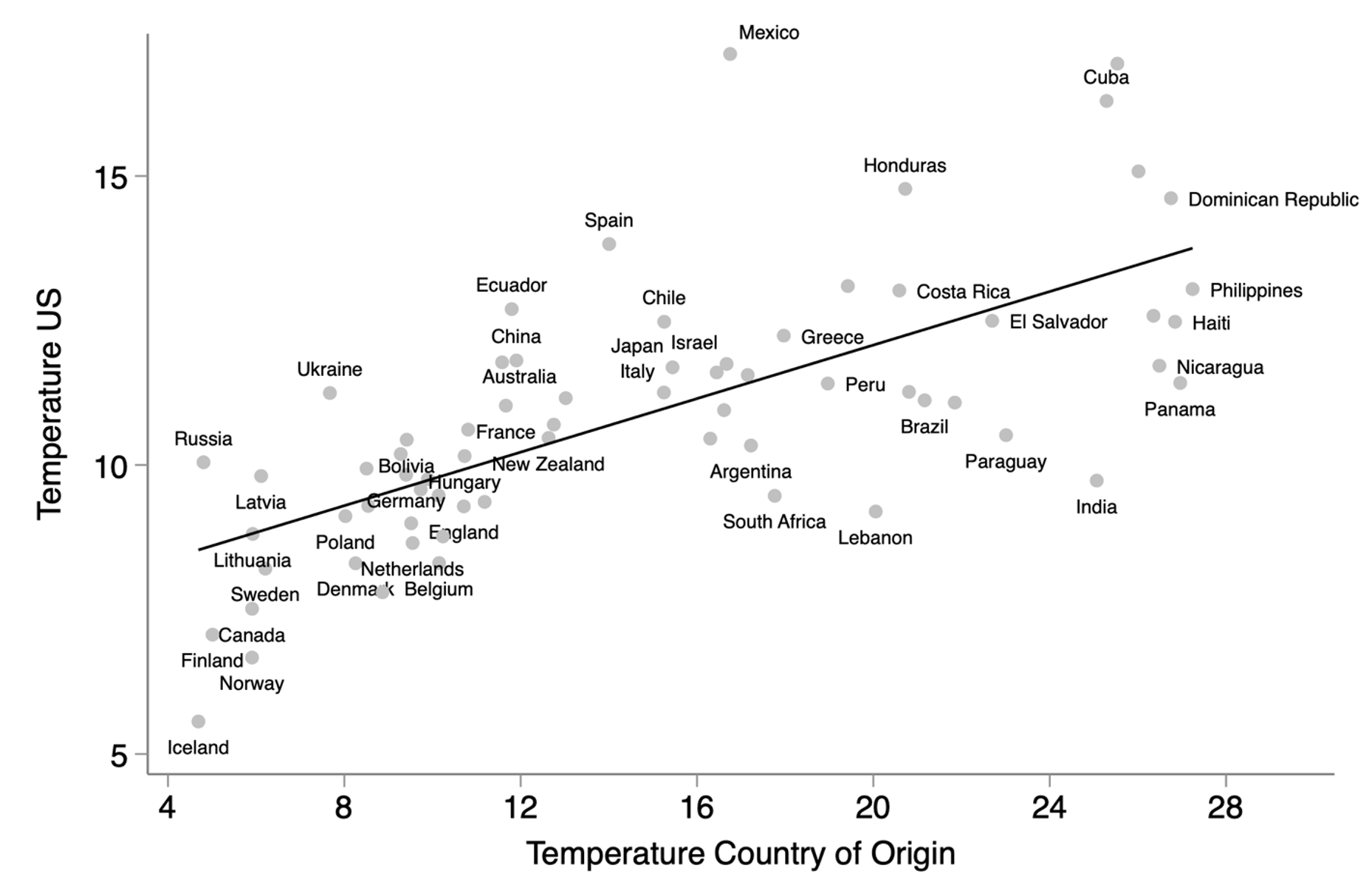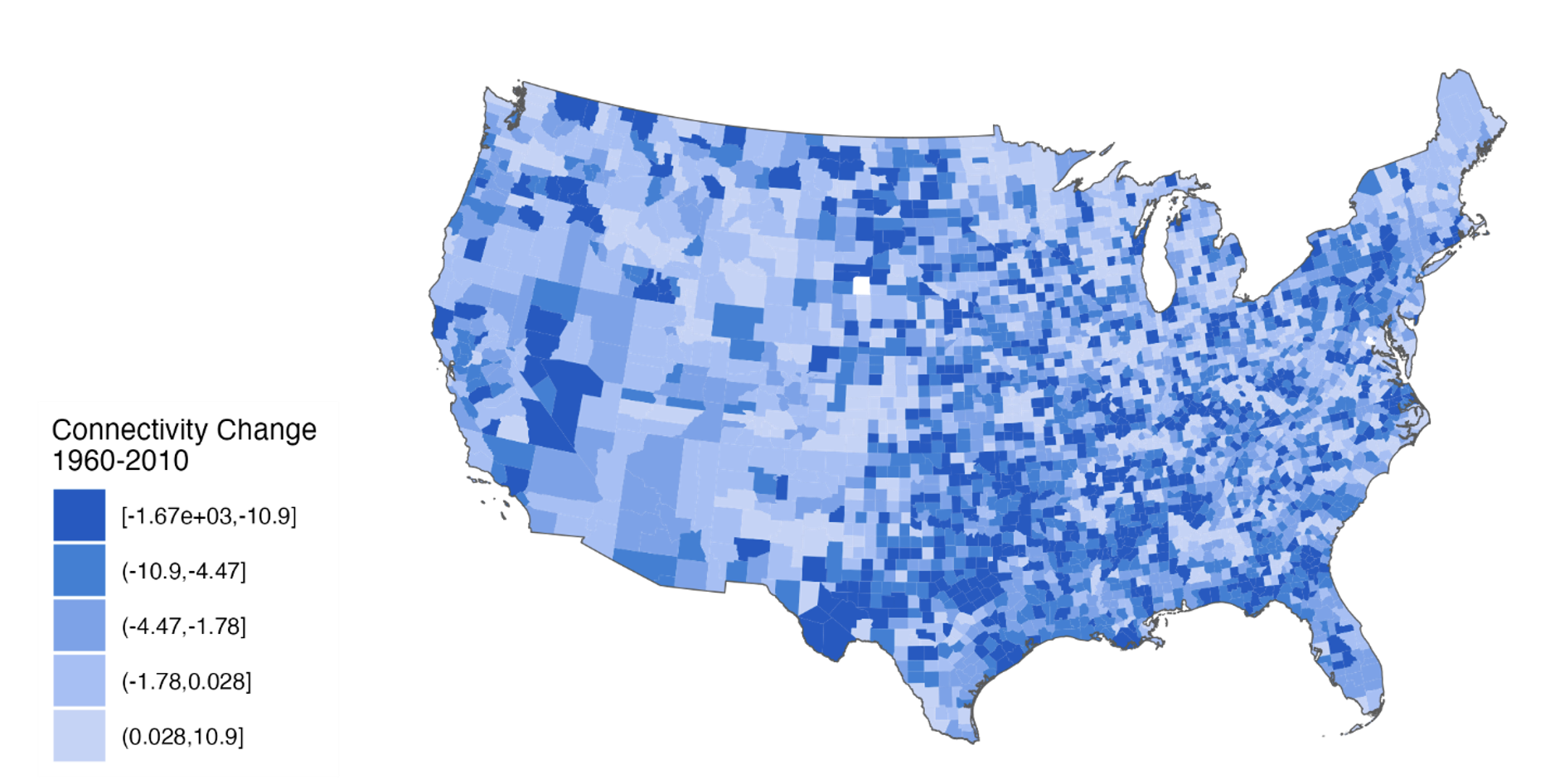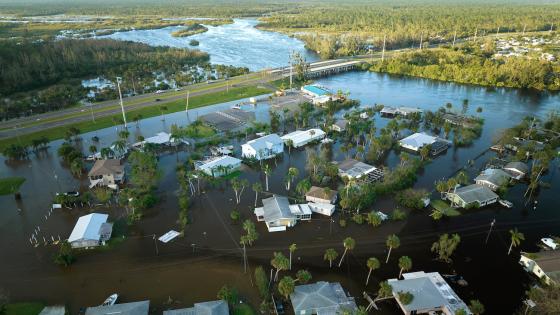Do migrants seek out familiar climates? The idea of ‘climate matching’, whereby people seek out destinations with climates aligned with those of their origin, is a recurrent theme in anecdotal and historical accounts. As early as the 1600s, the Englishman Sir Ferdinando Gorges argued that New England was “more suitable to the nature of our people, who neither finde content in the colder Climates, nor health in the hotter” (Kupperman 1984). Three centuries later, US President Calvin Coolidge observed that “the newcomers from Europe commonly sought climatic conditions here like those in which they had been raised. So the Scandinavians are found chiefly in the northern parts of this country” (Coolidge 1926: 255).
Are these anecdotes supported by systematic empirical evidence? With climate change increasingly driving migration (Stern 2007, Missirian and Schlenker 2017), answering this question is important for several reasons. First, climate similarity might help predict where people move or, in the case of forcibly displaced individuals (who are often constrained in their choices), where they would like to move. Second, climate matching might favour the geographic diffusion of climate-specific skills (Bazzi et al. 2016), with important consequences for productivity. Third, since climate change is not happening uniformly across the globe, climate similarity between and within countries will shift dramatically in the decades ahead, with possibly profound effects on migration.
In our recent paper (Obolensky et al. 2024), we consider US international and internal migration for both historical and modern periods. Figure 1 summarises our central result in a scatterplot of the average temperatures where immigrants settled in the US in 1880 against the average temperature in each migrant-sending country of origin. The figure indicates that immigrants coming from warmer (colder) countries settled in similarly warmer (colder) parts of the US. These results hold across time periods, including today, and do not merely reflect factors such as geographic distance, GDP of the country of origin, or past migration. They also hold across sources. The data used in Figure 1 were obtained from US full count censuses, which capture an individual’s residence at a given point in time.
Figure 1 Temperature matching of immigrants in the US, 1880
Notes: The figure displays the relationship between average temperature in degrees Celsius across US counties where immigrants from each origin were living in 1880 (y-axis) and the average temperature in the capital city of their country of origin (x-axis). The regression coefficient and the corresponding robust standard errors are, respectively, 0.231 and 0.033.
We find similar results when using mortality records for 1959–1961, which track the country of origin of each foreign-born individual who died in the US and are thus a proxy for where a person ended up settling.
Moving beyond cross-country correlations, we explore whether the climate-migration relationship holds within countries. First, we focus on German immigrants at the turn of the 20th century, when this group accounted for 30% of the US foreign-born population. We develop a novel measure of climate similarity based on the spatial distribution of surnames in Germany and in the US.
Second, we consider Norwegian immigrants between 1865 and 1880, when more than 250,000 individuals (15% of the 1865 Norwegian population) embarked for the US. Using automated algorithms developed in the literature (Pérez et al. 2020), we link the 1865 Norwegian and the 1880 US censuses to match individuals across locations (and the corresponding climates) over time.
Third, we turn to US internal migration from 1850 to 1940 – a period characterised by the westward expansion of the US (Bazzi et al. 2017). We rely on linked datasets assembled by Abramitzky et al. (2020) to follow migrants moving across US counties from one decade to the next. In all cases – Germans, Norwegians, and US domestic movers – migrants matched on climate: individuals from colder (warmer) origins settled in relatively colder (warmer) destinations in the US.
Motivated by these patterns, we estimate the effects of climate distance on migration at the origin-by-destination level using gravity equations common in the trade literature (Anderson and Van Wincoop 2003). We focus on the two settings for which we can measure origin and destination climates at a highly granular level: Norwegian immigration to the US between 1865 and 1920 and US domestic migration from 1850 to 1940. After linking individuals over time, we count the number of migrants from a given origin (a Norwegian municipality or a US county) to a given destination (a US county) for each decade. We define climate distance as the absolute value of the origin-destination difference in the average climate (temperature or precipitation). We find that migration is higher for pairs with more similar climates. The effect of temperature distance is quantitatively large – roughly equivalent to reducing geographic distance by 1,000 kilometres (e.g. New York City to Detroit) or raising wages at destination by 1%.
When examining the relationship between climate and migration, a key concern is that climate is spatially correlated and that our estimates may simply reflect geographic, rather than climate, distance. The Norway-US estimates are unlikely to suffer from this problem because the transatlantic component of migration breaks the potential spatial correlation of climate. Nevertheless, we perform several checks to probe the robustness of our results. Concerns about the spatial correlation of climate may be more relevant for US internal migration, since one might expect climate and geographic distances to be correlated.
In our setting, though, it turns out that geographic distance explains at most 22% and 31% of the variation in, respectively, temperature and precipitation distance between county pairs. To err on the side of caution, we always control for county-pair geographic distance and perform many robustness checks.
Our results are also robust to the inclusion of a large set of controls, such as bilateral differences in geographic features, soil type, and railroad connections. However, one may still be worried that our estimates reflect the influence of other origin-destination-specific variables also correlated with climate distance. To address this concern, we leverage shifts in average climate across counties throughout the 20th century, which are influenced by multi-decadal oceanic oscillations (e.g. North Atlantic Oscillation) as well as anthropogenic climate change. We find that changes in climate distance from 1900 to 2019 predict changes in migration between county pairs over the same period.
Mechanisms behind climate matching
What mechanisms can explain these findings? We start by exploring the role of ethnic enclaves. We examine the possibility that climate similarity determined the location of pioneers, and that subsequent migrants from the same origin merely followed the footsteps of the first movers without taking climate into account. While this scenario would not alter the validity of our findings, it would change their interpretation. We replicate the analysis, controlling for migration flows in previous decades from a given origin to a given destination. We also limit the sample to newly settled destinations, where the scope for ethnic networks to influence migrants’ location decisions is limited. In all cases, we continue to detect a strong relationship between climate similarity and migration.
We then consider two broad classes of complementary mechanisms. First are those capturing climate-specific human capital and skills (Steckel 1982, Bazzi et al. 2016). Intuitively, skill transferability should matter more in more weather-exposed occupations, such as agriculture. Supporting this channel, migration elasticities to climate distance are larger in magnitude for farmers than for non-farmers and become smaller over time as the share of the US population working in agriculture declined.
The second class of mechanisms involve climate as an amenity. Consistent with this channel, we find that climate distance influences migrants who work in sectors that are less tied to climate (e.g. services) and where climate-specific human capital is less relevant than for farmers. Moreover, we document that climate similarity predicts US domestic migration even today – when US workers are far more insulated from climate than in the past.
Economic implications
Finally, we discuss the economic implications of our findings. We begin by estimating the value of climate for migrants. In a first exercise, we leverage temporal and spatial variation across US counties generated by the 1862 Homestead Act, which transferred 10% of US land from the federal government to 1.6 million farmers (Edwards et al. 2017). We find that, by subsidising land, the Homestead Act reduced the role of climate distance in governing migration decisions. Contrasting counterfactual migration flows predicted by our estimates and using price differentials between Homestead land and other federal lands available for purchase, we estimate the value of one additional Celsius degree in climate similarity to be about $4,500 in current dollars.
In a second exercise, we use mortality records encompassing the universe of foreign-born individuals who died in the US between 1959 and 1961 to test the relationship between climate mismatch and life expectancy. Our analysis indicates that one additional Celsius degree of climate mismatch is associated with one-month reduction in lifespan. Figure 2 documents that the relationship between climate mismatch and mortality is remarkably symmetric and displays an inverted-U shape pattern. This resonates with the climate change literature that has documented increased mortality in response to both hot and cold shocks (Barreca et al. 2015, Heutel et al. 2021, Carleton et al. 2022). Expressing our results in terms of the Environmental Protection Agency’s value of a statistical life of $9.6 million (in 2020 dollars) implies that one additional Celsius degree similarity is worth around $14,300 per person in today’s dollars.
Figure 2 Temperature distance and age at death: Immigrants in the US, 1959–1961
Notes: The figure plots the coefficients, with corresponding 95% confidence intervals, of the regression of age of death on 1°C temperature distance bins for the difference in temperature between the US county of death and birth country capital. The 0°C bin is omitted, whereas the -6°C and 6°C bins include observations with differences beyond these thresholds. The sample includes all foreign-born individuals who died between 1959 and 1961 in the continental US. Regressions include fixed effects for US county of death, year of death, and country of birth, and individual controls (gender and marital status). Standard errors clustered at the US state by country of birth level.
Does climate matching help explain historical population growth patterns in the US? To answer this question, we combine our estimate of the elasticity of migration with respect to climate distance with the change in average temperature distance between each county-pair recorded during the 20th century. We derive a measure of climate connectivity similar in spirit to rail-based ‘market access’ in Donaldson and Hornbeck (2016). Using this measure, which is plotted in Figure 3, we then show that population growth from 1960 to 2010 was faster in US counties that experienced a stronger increase in their climate connectivity with other parts of the country.
Figure 3 Change in temperature-induced connectivity, 1940–2010
Notes: The figure depicts the change in temperature-induced connectivity between each contiguous US county pairs, between 1960 and 2010, due to oceanic oscillations and anthropogenic climate change. Temperature-induced connectivity is the weighted average of the change in climate-induced migration for each US county, with weights equal to historical county-pairs migration and is analogous to the market access index from Donaldson and Hornbeck (2016).
We also perform a similar analysis for the future, using localised climate change projections through the 21stcentury. Our estimates suggest that spatial heterogeneity in global warming will increase future climate connectivity in the US South, resulting in faster population growth there relative to other regions in the US.
To the best of our knowledge, our study is the first to estimate the effects of climate distance on historical migration patterns. Our results are relevant to the emerging literature that seeks to understand the spatial effects of climate shocks on the global economy through general equilibrium models. Such models assume that migration costs are exogenous to climate change (Cruz and Rossi-Hansberg 2021, Desmet and Rossi-Hansberg 2023, Bilal and Rossi-Hansberg 2023), but our findings indicate that migrants place a large weight on climate similarity between origin and destination. Climate distance can thus be viewed as a travel cost that depends on the spatial distribution of climate change. We hope that our results can be used to enrich these models, improving the precision of welfare estimates and the assessment of the macroeconomic effects of climate change.
Our findings are also relevant to climate refugee policy. Over 20 million people annually, on average, have been forcibly displaced by weather-related events since 2008 – a number that is estimated to increase with further global warming.
Even among economic migrants, climate change often acts as a push shock. Given the potential welfare and productivity implications, climate similarity should be taken into account when resettling existing climate refugees and when designing ‘managed retreat’ policies in anticipation of climate change.
References
Abramitzky, R, L Boustan, K Eriksson, S Perez, and M Rashid (2020), “Census linking project: Version 2.0 [dataset]”, data retrieved from https://censuslinkingproject. org.
Barreca, A, K Clay, O Deschênes, M Greenstone, and J S Shapiro (2015), “Convergence in adaptation to climate change: Evidence from high temperatures and mortality, 1900–2004”, American Economic Review 105: 247–51.
Bazzi, S, M Fiszbein, and M Gebresilasse (2017), “Individualism and opposition to redistribution in the US: The cultural legacy of the frontier”, VoxEU.org, 23 December.
Bazzi, S, A Gaduh, A D Rothenberg, and M Wong (2016), “Skill transferability, migration, and development: Evidence from population resettlement in Indonesia”, American Economic Review 106: 2658–98.
Bilal, A, and E Rossi-Hansberg (2023), “The importance of anticipating climate change”, VoxEU.org, 24 July.
Carleton, T, A Jina, M Delgado, M Greenstone, T Houser, S Hsiang, A Hultgren, R E Kopp, K E McCusker, I Nath et al. (2022), “Valuing the global mortality consequences of climate change accounting for adaptation costs and benefits”, Quarterly Journal of Economics 137: 2037–105.
Coolidge, C (1926), Foundations of the republic; speeches and addresses, New York: Scribner.
Cruz, J-L, and E Rossi-Hansberg (2021), “Unequal gains: Assessing the aggregate and spatial economic impact of global warming”, VoxEU.org, 2 March.
Desmet, K, and E Rossi-Hansberg (2023), “Climate change economics over time and space”, working paper.
Donaldson, D, and R Hornbeck (2016), “Railroads and American economic growth: A ‘market access’ approach”, Quarterly Journal of Economics 131: 799–858.
Edwards, R, J K Friefeld, and R S Wingo (2017), Homesteading the plains: Toward a new history, University of Nebraska Press.
Heutel, G, N H Miller, and D Molitor (2021), “Adaptation and the mortality effects of temperature across US climate regions”, Review of Economics and Statistics 103: 740–53.
Kupperman, K O (1984), “Fear of hot climates in the Anglo-American colonial experience”, The William and Mary Quarterly 41: 213–40.
Missirian, A, and W Schlenker (2017), “Asylum applications respond to temperature fluctuations”, Science 358: 1610–14.
Obolensky, M, M Tabellini, and C A Taylor (2024), “Homeward bound: How migrants seek out familiar climates”, working paper.
Pérez, S, J Feigenbaum, L Boustan, K Eriksson, and R Abramitzky (2020), “The promise of automated historical data linkage”, VoxEU.org, 14 February.
Steckel, R H (1982), “The economic foundations of east-west migration during the nineteenth century”, National Bureau of Economic Research.
Stern, N H (2007), The economics of climate change: The Stern review, Cambridge University Press.









